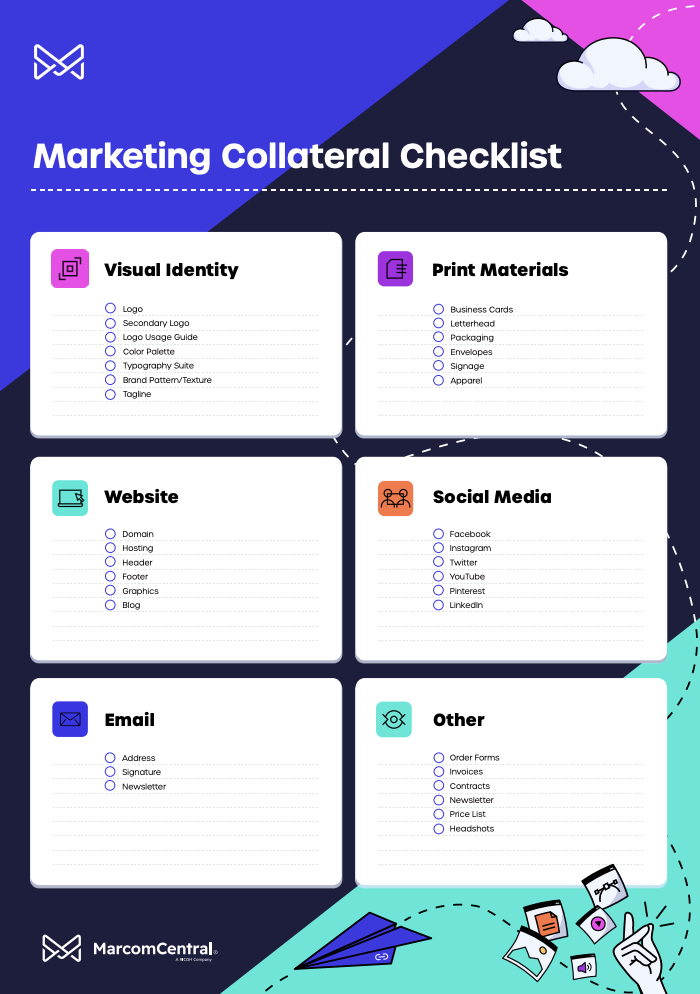Get news, updates, and insights delivered straight to your inbox.
Best Practices for Marketing Collateral Management

From e-books to infographics to printed brochures, today’s businesses are constantly creating a wealth of assets and marketing collateral to support their branding and creative efforts to support their business goals. Why? Let’s think about the buyer’s journey. As a brand, it takes time and effort to gain the trust of your potential customers, but how can you accomplish this? Because most Americans are now exposed to 4,000 to 10,000 ads each day, it’s important for brands to refine their marketing efforts by connecting with their audience and presenting a clear message.
According to Salesforce, it takes approximately six to eight touches to generate a viable sales lead, as many consumers are merely gathering information and gaining brand awareness during the early stages of the buyer’s journey. So, how do we use marketing collateral material to move them beyond the awareness stage? First, you might use digital marketing channels like social media or digital display ads to get your product or service in front of your target audience while they’re scrolling on Twitter, LinkedIn, etc. If they click on the ad and land on your website, they might enter their email to subscribe to your weekly email marketing newsletter. In the newsletter, they’ll find a plethora of useful blog posts or maybe even click to download an e-book. All of this great marketing collateral is necessary to nurture prospective customers at each stage of the buyer’s journey so they will feel confident when selecting your product or service.
But as marketing collateral begins to pile up, assets can easily become lost in translation. It becomes increasingly difficult for employees to sort through various marketing material and files to find the ones they need. Where are those sell sheet templates stored? Which server are those custom social media graphics on? As your company continues to grow and create more branded content in an effort to build trust with potential customers, keeping these assets organized will become a crucial part of your integrated marketing strategy. But how can asset management work when you don’t even know what’s there? Let’s go through some simple steps and best practices to follow that will help your brand effectively manage your marketing collateral material and empower marketing and sales teams.
First, What Is Marketing Collateral?
Marketing collateral can be defined as any material used to promote or support the sales of a product or service. These media assets may range from materials like posters and flyers to digital content like images and blog posts.
In other words, anything used to communicate your brand to consumers can be considered marketing collateral.
What Is The Best Way to Manage Marketing Collateral?
1. Take Inventory & Analyze Your Assets
Taking inventory of your marketing assets is an essential first step in marketing collateral management, whether you already have management software in place or if you’re conducting a first-time audit. Once you’ve conducted an audit of all of your content, whether it be business cards, infographics, or anything in between, you can begin to categorize these materials. Taking a detailed inventory of your marketing materials will tell you just what you’re working with.
After categorizing your marketing collateral, you can begin to actually analyze the assets. Forrester states that about 60-70% of content produced by B2B marketing organizations goes unused, so categorizing your assets can help eliminate some of this clutter. Determine what can be repurposed, what needs to be updated, and what should be retired. If you’re struggling to start this process, think about what the goal of each asset is. Ask yourself, “Are these assets being regularly used? When was the last time we actually used these content marketing templates for a campaign? Will this help the business in the future?”

FREE MARKETING COLLATERAL CHECKLIST
Download our visual checklist to ensure your marketing assets are on-brand and ready to go.
Download the Free Checklist
Additionally, analyzing your marketing and sales collateral will allow you to recognize and eliminate any duplicate or old files. Old or duplicate versions of content can lead to confusion and inconsistent brand materials being used, which can ultimately deteriorate brand equity. By eliminating old or duplicate content, you significantly lower your risk of incorrectly branded materials from being used for marketing campaigns and protect brand consistency.
2. Make Your Assets Readily Available
After you’ve decided what digital assets to keep and use as part of your marketing strategy, ensure that these materials are made readily available to those who need them. An easy way to do this is by implementing a marketing asset management solution. According to the American Psychological Association, more than 26 million Americans now work remotely at least part of the time. As more marketing and creative teams are increasingly working remotely, they will need access to marketing collateral at all times and on a number of different devices in order to effectively perform their jobs. A marketing asset management system can help ensure that the most relevant content is always available to local marketers and global sales teams at all times.
While on one hand it’s important for your teams to be able to quickly find and access materials, security and privacy must also remain a priority. Within your software, establish certain levels of permission for different users. This will ensure that individuals can only access the assets necessary to their work and not inadvertently sabotage higher-level initiatives in the process.
3. Adapt Your Assets
Finally, ensure that you’re getting the most bang for your buck with your marketing assets by making them adaptable. Repurpose your content across different media types for a range of solutions. With the help of a marketing asset management solution, you can manage both offline assets (such as direct mail and branded promotional goods) and digital assets (such as email, PowerPoint presentations, and social media posts), to support an integrated, cross-channel strategy. This will also allow for stronger brand management and easier digital asset distribution across your marketing channels, all while maintaining brand compliance.
Having a treasure trove of marketing materials doesn’t mean you can’t keep your assets organized. By following basic best practices for marketing collateral management and instilling the help of marketing asset management software, you can empower your teams to create compelling campaigns efficiently without jeopardizing brand equity.


